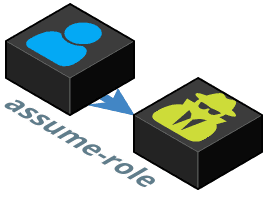Assume IAM roles through an AWS Bastion account with MFA or SAML Provider via the command line.
AWS Bastion accounts store only IAM users providing a central, isolated account to manage their credentials and access. Trusting AWS accounts create IAM roles that the Bastion users can assume, to allow a single user access to multiple accounts resources. Under this setup, assume-role makes it easier to follow the standard security practices of MFA and short lived credentials.
SAML Providers allow you to use federated login to assume-role-with-saml. SAML Assertions should be formatted as following according to AWS.
assume-role requires jq and aws CLI tools to be installed.
brew tap coinbase/assume-role
brew install assume-roleYou can then upgrade at any time by running:
brew upgrade assume-roleYou can install/upgrade assume-role with this command:
curl https://raw.githubusercontent.com/coinbase/assume-role/master/install-assume-role -O
cat install-assume-role # inspect the script for security
bash ./install-assume-role # install assume-roleIt will ask for your sudo password if necessary.
If you are using a bastion setup (the default), make sure that credentials for your AWS bastion account are stored in ~/.aws/credentials.
Out of the box you can call assume-role like:
eval $(assume-role account-id role mfa-token)If your shell supports bash functions (e.g. zsh) then you can add source $(which assume-role) to your rc file (e.g. ~/.zshrc), then you can call assume-role like:
assume-role [account-id] [role] [mfa-token]assume-role this method can be used with arguments or interactively like:
If you would like to authenticate with your SAML provider using username and password instead, add this to your .bash_profile or .bashrc:
export AWS_ASSUME_ROLE_AUTH_SCHEME=saml # defaults to bastion
export SAML_IDP_ASSERTION_URL="your saml idp assertion url"
export SAML_IDP_NAME="Name of your IdP registerd with AWS"
# This is an example body template.
export SAML_IDP_REQUEST_BODY_TEMPLATE='{"service": "aws", "email": "$saml_user", "password": "$saml_password"}'
The URL should serve a POST API that returns a SAML Assertion under the saml_response JSON key.
You can specify your JSON body via an envar that uses the saml_user and saml_password envars. You can specify any body template you want.
Your service should be hosted over SSL since credentials might be sent in the response, depending on your JSON body implementation. You could hash the password client-side if you wish to do so in the template envar
The script will warn you if you are not serving over SSL.
Once you assume-role, you will be prompted for your SAML credentials (username and password).
If you would like to store your credentials on the filesystem for ease of use, you can create a ~/.saml/credentials file that looks as such:
username = lukeskywalker
password = hunter2
You can define aliases to account ids in ~/.aws/accounts which assume-role can use, e.g.
{
"default": "123456789012",
"staging": "123456789012",
"production": "123456789012"
}With this file, to assume the read role in the production account:
assume-role production read
# OR
assume-role 123456789012 readAlso, by setting $AWS_PROFILE_ASSUME_ROLE, you can define a default profile for assume-role if you want to separate concerns between
default accounts for assume-role and vanilla awscli or simply to have better names than default:
$ export AWS_PROFILE_ASSUME_ROLE="bastion"
$ assume-role production readMoreover, if you are in the need of longer client-side assume-role sessions and don't want to enter your MFA authentication every hour (default) this one is for you:
$ export AWS_ROLE_SESSION_TIMEOUT=43200However, be aware that for chained roles there's currently a forced 1 hour limit from AWS. You'll get the following error if you exceed that specific limit:
DurationSeconds exceeds the 1 hour session limit for roles assumed by role chaining.
Here is a simple example of how to set up a Bastion AWS account with an id 0987654321098 and a Production account with the id 123456789012.
In the Production account create a role called read, with the trust relationship:
{
"Statement": [
{
"Effect": "Allow",
"Principal": {
"AWS": "arn:aws:iam::0987654321098:root"
},
"Action": "sts:AssumeRole",
"Condition": {
"Bool": {
"aws:SecureTransport": "true",
"aws:MultiFactorAuthPresent": "true"
},
"NumericLessThan": {
"aws:MultiFactorAuthAge": "54000"
}
}
}
]
}The conditions aws:MultiFactorAuthPresent and aws:MultiFactorAuthAge forces the use of temporary credentials secured with MFA.
In the Bastion account, create a group called assume-read with the policy:
{
"Statement": [
{
"Effect": "Allow",
"Action": [ "sts:AssumeRole" ],
"Resource": [ "arn:aws:iam::123456789012:role/read" ],
}
]
}Attach this group to Bastion users that should be able use read's policies in the Production account.
You can assume the read role in Production by running:
assume-role 123456789012 read
Then entering a MFA token on request.
The SAML Provider will need to be registered in the same AWS account that you are doing assume-role-with-saml into. If you are dealing with many accounts, the suggested way to handle this is to have one deployment of your SAML Provider that returns assertions for several accounts/roles using the registered SAML Provider ARN and the role ARN.
Here is a simple example of how to set up a SAML Provider in a Production account with the id 123456789012.
In the Production account create a saml provider called saml-idp, and a role called read with the trust relationship:
{
"Statement": [
{
"Effect": "Allow",
"Principal": {
"Federated": "arn:aws:iam::123456789012:saml-provider/saml-idp"
},
"Action": "sts:AssumeRoleWithSAML",
"Condition": {
"Bool": {
"aws:SecureTransport": "true",
},
"StringEquals": {
"SAML:aud": "https://signin.aws.amazon.com/saml"
}
}
}
]
}And configure your SAML Provider to return signed assertions for the read role in the Production acount.
If you are using zsh you can get a sweet prompt by adding to your .zshrc file:
# AWS ACCOUNT NAME
function aws_account_info {
[ "$AWS_ACCOUNT_NAME" ] && [ "$AWS_ACCOUNT_ROLE" ] && echo "%F{blue}aws:(%f%F{red}$AWS_ACCOUNT_NAME:$AWS_ACCOUNT_ROLE%f%F{blue})%F$reset_color"
}
# )ofni_tnuocca_swa($ is $(aws_account_info) backwards
PROMPT=`echo $PROMPT | rev | sed 's/ / )ofni_tnuocca_swa($ /'| rev`For bash you could put the following in your .bash_profile file:
function aws_account_info {
[ "$AWS_ACCOUNT_NAME" ] && [ "$AWS_ACCOUNT_ROLE" ] && echo -n "aws:($AWS_ACCOUNT_NAME:$AWS_ACCOUNT_ROLE) "
}
PROMPT_COMMAND='aws_account_info'assume-role is tested with BATS (Bash Automated Testing System). To run the tests first you will need bats, jq and shellcheck installed. On macOS this can be accomplished with brew:
brew install bats
brew install jq
brew install shellcheckThen run bats test/assume-role.bats;

